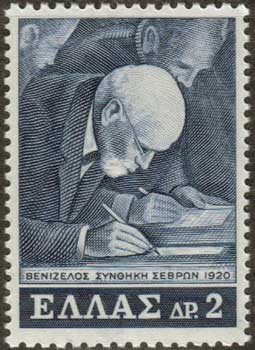|
|
Venizelos signs the Treaty of Sevres The Treaty of Sèvres of August 10, 1920, was a peace treaty between the Entente and Associated Powers1 and the Ottoman Empire after World War I. The treaty was signed by the Ottoman Goverment, but Mehmed VI never signed that treaty. However, it was rejected by the Turkish republican movement, and never came into effect. That movement, under the leadership of Kemal Atatürk, used the treaty as the occasion to declare itself the rightful government of Turkey, replacing the monarchy based in Istanbul (Constantinople) with a republic based in Ankara. The Ottoman Empire would have lost a great deal of territory by the terms of this treaty, which followed the outlines of earlier agreements between the Allies at the Conference of San Remo in April 1920. Hejaz (now part of Saudi Arabia) and Armenia were to become independent. Kurdistan was to be given autonomy. In accordance with the wartime Sykes-Picot Agreement, Mesopotamia and Palestine were assigned under mandate to the tutelage of the United Kingdom, Lebanon and an enlarged Syria to that of France. The Dodecanese and Rhodes (already under Italian occupation since 1911), with portions of southern Anatolia, were to pass to Italy, while Thrace and Western Anatolia, including the key port of Smyrna (now Izmir), would become part of Greece. The Bosphorus, Dardanelles and Sea of Marmara were to be demilitarized and internationalized, and the Ottoman army was to be restricted to a strength of 50,000 men. The nationalist government in Ankara rejected the terms of the treaty and resisted the Greek army's advance into the area assigned to Greece in Western Anatolia, and its further unilateral advance towards Ankara. Following the Greco-Turkish War (1919-1922) and the disastrous defeat of the Greek forces, a peace agreement was signed with the Soviet Union. These events forced the former wartime Allies to return to the negotiating table, and the terms of Sèvres were revised in Turkey's favor by the Treaty of Lausanne in 1923. A map depicting the effects of Sèvres upon Turkey Footnotes The Entente and the Associated Powers were the United Kingdom, France, Italy, Japan (Principal Allied Powers), Greece, Belgium, Armenia, the Hedjaz (Saudi Arabia), Poland, Portugal, Romania, the Kingdom of Serbs, Croats and Slovenes (Yugoslavia) and Czechoslovakia.
Links Armenia and Turkey in Context of the Treaty of Sevres: Aug - Dec 1920 - on "Atlas of Conflicts" by Andrew Andersen
Retrieved from "http://en.wikipedia.org/"
 |
||||||||||||||||||

